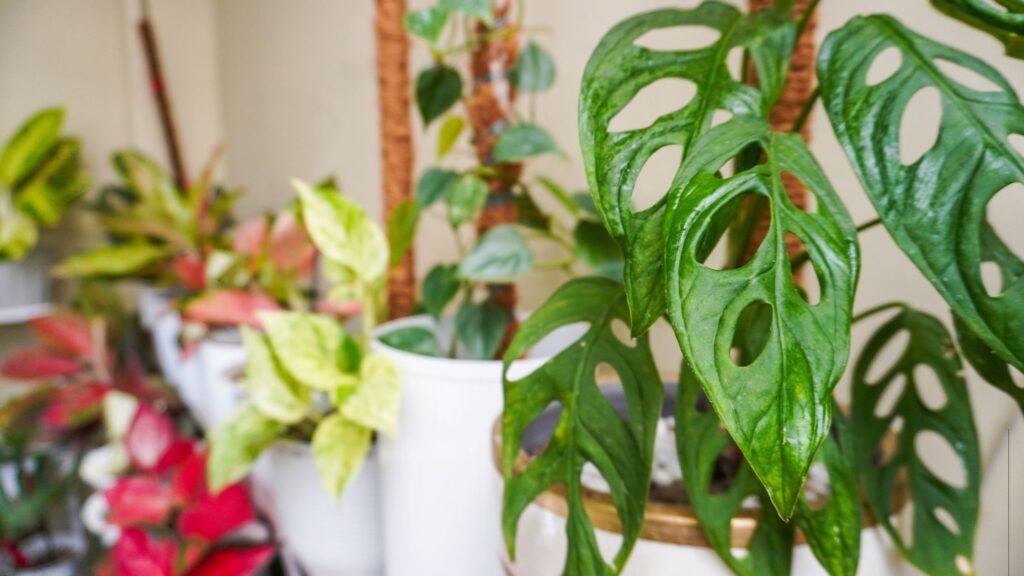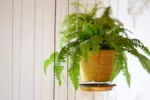Broken Heart Plant
The Broken Heart Plant, commonly known as the Philodendron Billietiae or the Swiss Cheese Plant with heart-shaped leaves, is a beautiful and relatively low-maintenance houseplant. It’s known for its glossy, heart-shaped leaves that develop split lobes or holes as the plant matures.

Broken Heart Plant Care
The Broken Heart Plant, also known as Monstera adansonii, is a popular houseplant known for its distinctive split leaves. Here’s how to care for it:
- Light: It can withstand moderate shade, but it likes bright, indirect light.
- Water: Keep the soil wet but not soggy. Let the top inch of soil dry between waterings.
- Soil: Use a well-draining potting mix. Monstera adansonii enjoys peat-based soil that retains moisture without becoming soggy.
- Fertilizer: Feed the plant with a balanced fertilizer every 3-4 weeks during the growing season. Avoid fertilizing in winter.
- Humidity: It thrives in high-humidity environments. You may raise the humidity by spraying the leaves or installing a humidifier nearby.
- Temperature: Maintain a warm environment, ideally between 65°F and 85°F (18°C and 29°C).
- Repotting: The plant should be repotted every 1-2 years or when it outgrows its current container. Use one size larger pot and fresh potting soil.
Broken Heart Money Plant
The term “Broken Heart Money Plant” is likely a combination of two popular houseplants: the Broken Heart Plant (Philodendron Billietiae) and the Money Plant (Epipremnum aureum).
- Broken Heart Plant (Philodendron Billietiae): This plant is known for its glossy, heart-shaped leaves that develop split lobes or holes as the plant matures. It’s a beautiful and relatively low-maintenance houseplant. Despite its name, it doesn’t have any symbolic connection to heartbreak.
- Money Plant (Epipremnum aureum): Also known as Pothos, this is a popular vining plant with heart-shaped leaves (though not as distinctly shaped as the Broken Heart Plant). In certain cultures, it is believed to bring prosperity and good health.
Broken Heart Plant In Water
- The Broken Heart Thrives in Water: A Guide to a Happy Aquatic Life
The Broken Heart Plant, or Philodendron Billietiae, can not only mend your metaphorical heartbreak but also flourish in a cool glass of water. Here’s how to create a thriving aquatic haven for your leafy friend:
Preparation:
- The Plant: Choose a healthy stem cutting with at least a few nodes (the bumpy bits where leaves emerge). Remove any lower leaves that might rot underwater.
- The Vessel: Pick a transparent container that allows you to monitor root growth. A glass vase or a mason jar works well.
Creating the Perfect Habitat:
- Fresh Water: Use filtered or tap water that has sat out for 24 hours to release chlorine.
- Light it Up: Broken Hearts enjoy bright, indirect sunlight.To prevent the foliage from being scorched, it is important to avoid the harsh midday sun. A north-facing window is ideal.
- Finding Balance: The water level should reach just below the lowest node on the stem. Submerged nodes will rot.
Happy Plant, Happy Life:
- Root Power: Be patient! Roots can take a few weeks to develop. Once established, change the water every 7-10 days to prevent mineral build-up.
- Keeping it Clean: Wipe the inside of the container occasionally to remove algae buildup.
- Fertilize Lightly: During the growing season (spring and summer), a diluted liquid fertilizer specifically for water plants can be added monthly, but be mindful of over-fertilizing.
A Few Words of Caution:
- Limited Nutrients: Water propagation provides less access to nutrients compared to soil. Your Broken Heart Plant’s growth might be slower, and it may not reach its full size.
- Longing for Land: While the Broken Heart Plant can live happily in water for a long time, it can also be transitioned to soil later if you desire a bushier plant.



Thanks for any other magnificent post. The place else could anybody get that kind of information in such an ideal way of writing? I’ve a presentation next week, and I am at the look for such information.
Very interesting details you have noted, appreciate it for putting up. “Jive Lady Just hang loose blood. She gonna handa your rebound on the med side.” by Airplane.